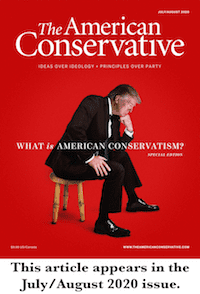Have Faith A New Fusionism Can Work

American conservatism—which is traditionally quite different from conservatism in the rest of the world —is under stress as a coherent political and philosophical movement. Like the larger body politic, the conservative tent is becoming increasingly fractured. Instead of Frank Meyer’s fusionism, we have centrifugalism. But if we can come together around a faith in the ideals and institutions traditionally embraced by American conservatives, we can create a new fusionism that is attractive to a majority of our country and useful to solving today’s problems.
While it would be tempting to blame any number of causes for the cracking of the movement, the problem of a coherent conservatism isn’t entirely new.
The disappearance of the Soviet Union and the communist threat in 1991 eliminated a major systemic force that pushed disparate elements of American conservatism together. People on the so-called Right have been at it hard ever since. Buchananites and neoconservatives have been clawing at each other’s throats on foreign policy for decades; an increasing percentage of liberal conservatives (aka classical liberals and libertarians) have drifted from Thomas Sowell’s “constrained” vision and become less and less attached to traditional mores and values; and a strand of social conservative thought suspicious of individual liberty has been on the rise over the past few decades.
Of course, regular old conservatives have always been part of the mix, moving this way or that as the various factions struggled with each other over time. These conservatives are still among us, especially in the hustings where sectarian debates are less salient. But some of these conservatives, in conjunction with what’s left of neoconservatism, might be called a new Eastern Establishment that fondly recalls the Bush presidencies, hates Trump, and still reads David Brooks for what are believed to be conservative insights. In other words, the attendees at the admittedly fun AEI gala.
Recently, a more government-friendly “national conservatism” has emerged (though what it stands for exactly is still a work in progress). Its most extreme members—like the integralists—represent a rejection of an explicitly American conservatism—that is to say, a rejection of the elements of classical liberalism that have long been a bulwark of what makes American conservatism, well, American. The more moderate wing circling in this orbit is less hostile to freedom and markets, while still rejecting its purer forms. But they are so anxious about the current moment, which they ascribe largely to libertarianism run amok at home and unfair competition from abroad, that they are willing to support more government activism to deliver a “patterned end state” more to their liking.
But even these post-Cold War battles weren’t novel. They were just instantiations of the political and philosophical fissures that have been there from the start within the post-New Deal American conservative movement. Let’s not forget that Meyer’s fusionism was criticized from the very beginning by libertarians like Rothbard and traditionalists like Bozell, leading to the first “What is Conservatism?” symposium. Nor should we ignore that, at arguably the height of (political) fusionism symbolized by the Reagan presidency, Kirk attacked the libertarians as “chirping sectaries” and got as well as he gave. So the J.D. Vances today are walking a well-trod path.
But the centrifugalism we see now seems more severe. Perhaps this is due to the fact that there is simply a lot less clustering around a shared political culture in today’s America. The range of political thought in America—right and left—is just much broader. Witness today’s democratic socialists and the anti-liberal integralists. In other words, Louis Hartz’s thesis that everyone in America is broadly a liberal of one sort or another is dead (though it has always been suspect given how substantially the Progressives and New Dealers broke with the liberal tradition).
So today, as the country at large is fracturing politically and culturally, we have a wide variety of perspectives within American conservatism struggling to define what it ought to mean—or in the case of some liberal conservatives, breaking from an association with the brand altogether.
But what should American conservatism look like ahead and what does it need to stand for? Where do we go from here in order to weave together a movement that is politically sustainable and philosophically coherent? How can those of us who believe that there is something still worth conserving in the American experiment in liberty and democracy connect our principles and values to the challenges of our day?
This brings me to Calvin Coolidge, whose essay “Have Faith in Massachusetts” instantly jumped to mind when I was asked to comment on conservatism today. Why?
It seems as if many American conservatives—a particular brand of conservatism that has always aimed at conserving the authentic classical liberal political tradition of America while also espousing a certain cultural vision of virtue, personal responsibility, and community—have lost some faith in their tradition and the distinctly American ideals and institutions that it supports. Yet this moment is just when we need to embrace them. A new fusionism could be found by reengaging with that tradition and energetically applying these insights to our country’s challenges today.
Coolidge, after being elected state senate president in 1914, reminded his fellow Bay Staters that they too needed to stay true to what Massachusetts stood for and had produced. He noted that: “In some unimportant detail some other States may surpass her, but in the general results, there is no place on earth where the people secure, in a larger measure, the blessings of organized government, and nowhere can those functions more properly be termed self-government.”
The rest of the essay exemplifies a philosophy that American conservatism has traditionally stood for: representative government, the moral dignity of all, the protection of natural rights including those of the less powerful, personal character and thrift, honest work and industry, and the just acquisition and protection of property.
Conservatism needs to double down on a faith in America exemplified by the principles that Coolidge extolled. We need to see power in the ability of its people to do great things when they are free to do so. Indeed, we need to harken back to the best of the American experiment and away from the siren songs of government control, a managed economy, and the centralized warfare/welfare state. It is the ideals of the Declaration and the institutions of our constitutions that have served America so well since our founding.
A renewed fusionism would also appreciate what the different strands of conservatism have emphasized, but bring them together into a coherent whole. It would accept what the social conservatives remind us: that there are certain values that are foundational to a well-functioning free society and that not every consensual behavior is conducive to our flourishing. But it would also accept, from the classical liberals, that freedom is not only a means to a healthy economy that allows everyone to rise, but a precondition of true virtue. And a new fusionism would appreciate the need for thriving local communities in which civil society takes greater responsibility for alleviating social ills. 
What would a practical and energizing program look like that could bring conservatives together? We could start by putting the same vigor into removing other barriers to people creating value for themselves and their communities as we have around tax cuts. We can march together to reform overregulation that stymies entrepreneurialism, cronyist rent-seeking that privileges the connected over Main Street, and an education system unsuited to today’s needs. It also means reimagining how we can encourage, within the framework of a free society, personal virtue while taking the dangers of vice a lot more seriously, both for individuals and the communities they live in. Naturally, for conservatives, this would be bottom-up rather than top-down. So more moral suasion and catalyzing Tocqueville’s associational life and Burke’s little platoons, less Washington diktat. It would mean support for a strong, confident national defense but one guided by realism and restraint. That would entail ending endless wars and militarized nation-building that lack the characteristic humility of conservatism and distract us from our own needs at home, whether fiscal responsibility, pandemic preparation, or criminal justice reform. And it would mean having the confidence of our convictions, fighting for First Amendment rights and using them to evangelize for what Coolidge so eloquently laid out in his own testimony.
Have faith in our uniquely American brand of conservatism and have faith in America.
William Ruger is the vice president of research and policy at the Charles Koch Institute.
Related: Introducing the TAC Symposium: What Is American Conservatism?
See all the articles published in the symposium, here.
Comments